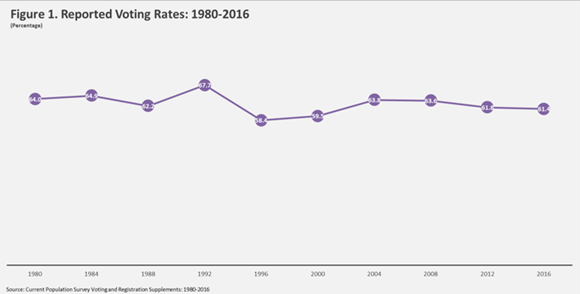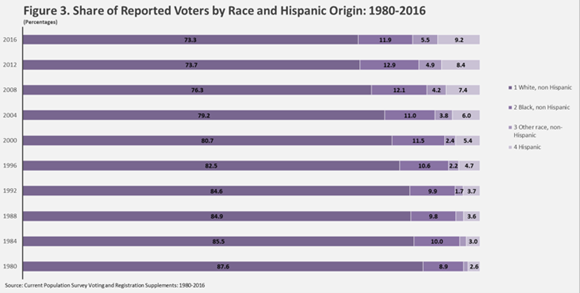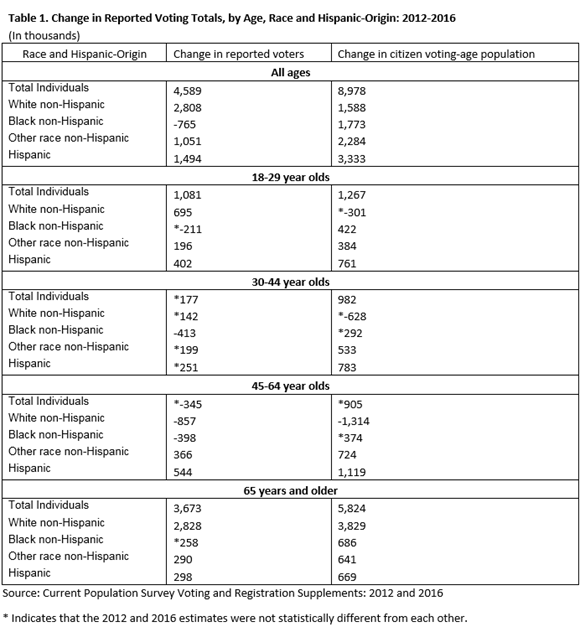Voting in America: A Look at the 2016 Presidential Election
Voting in America: A Look at the 2016 Presidential Election
Since 1964, the U.S. Census Bureau has fielded the Voting and Registration Supplement to the Current Population Survey every two years. Today, the Census Bureau released a series of tabulations and data products alongside a public use data file for the November 2016 presidential election.
In addition to the requirement that individuals be at least 18 years old, voters in national elections must also be U.S. citizens. Although the Census Bureau has collected voting and registration data since 1964, the Current Population Survey has gathered citizenship data since 1978. Figure 1 presents voting rates for the citizen voting-age population for each presidential election since 1980. In 2016, 61.4 percent of the citizen voting-age population reported voting, a number not statistically different from the 61.8 percent who reported voting in 2012.
Voting rates have historically varied by race and Hispanic origin (Figure 2). In 2012, voting rates for non-Hispanic blacks (66.6 percent) were higher than non-Hispanic whites (64.1 percent) for the first time in this series. In 2016, turnout increased to 65.3 percent for non-Hispanic whites, but decreased to 59.6 percent for non-Hispanic blacks.
For the most part, from 1980 to 2012, the share of reported voters who were non-Hispanic white decreased from one presidential election cycle to the next (Figure 3).1 In 1980, 87.6 percent of reported voters were non-Hispanic white, but by 2012, this number decreased to 73.7 percent. Over this same period, the distribution of voters who reported being either non-white or Hispanic increased in most elections.2 However, in 2016, for only the second time in this series, the percentage of voters who were non-Hispanic white (73.3) was not statistically different from the previous presidential election, meaning that the consistently observed year-to-year decrease did not occur in this most recent cycle. Additionally, 2016 was only the second election in this series where the share of non-Hispanic black voters decreased, from 12.9 percent in 2012 to 11.9 percent in 2016.3
Voting rates have also historically varied according to age, with older Americans generally voting at higher rates than younger Americans (Figure 4). In 2016, this was once again the case, as citizens 65 years and older reported higher turnout (70.9 percent) than 45- to 64-year-olds (66.6 percent), 30- to 44-year-olds (58.7 percent) and 18- to 29-year-olds (46.1 percent). However, in 2016, young voters ages 18 to 29 were the only age group to report increased turnout compared to 2012, with a reported turnout increase of 1.1 percent. All older age groups either reported small yet statistically significant turnout decreases (45- to 64-year-olds and those age 65 and older) or turnout rates not statistically different from 2012 (30- to 44-year-olds).
When analyzed together, reported turnout by age, race and Hispanic origin differed in 2016 as well. In comparison to 2012, younger non-Hispanic whites between the ages of 18 to 29 and between the ages of 30 to 44 reported higher turnout in 2016, while voting rates for the two oldest groups of non-Hispanic whites were not statistically different (Figure 5). Meanwhile, for non-Hispanic blacks, turnout rates decreased in 2016 for every age group. For other race non-Hispanics and Hispanics of any race, voting rates between 2012 and 2016 were not statistically different for any age groups.
In any given presidential election, the number of reported voters typically increases relative to the previous presidential election, largely as a product of increases in the size of the citizen voting-age population. Table 1 shows changes in both the number of reported voters and the citizen voting-age population between 2012 and 2016. Overall, in 2016, there were about 4.6 million more reported voters than in 2012. A majority of these additional voters (3.7 million) were 65 years and older. Remember, despite these additional reported voters, the overall voting rate was not statistically different between the two elections.
When analyzed alongside race and Hispanic origin, in 2016 a large portion of the additional reported voters (2.8 million) were non-Hispanic whites who were also 65 years of age and older.
In addition to race, Hispanic origin and age, reported voting rates varied according to a variety of other social, demographic and economic factors as well. Readers are invited to explore the Census Bureau’s additional voting and registration resources for the 2016 election and beyond.
Voting estimates from the Current Population Survey and other sample surveys have historically differed from those based on administrative data, such as the official results reported by each state and disseminated collectively by the Clerk of U.S. House of Representatives and the Federal Election Commission. In general, voting rates from the sample surveys such as the Current Population Survey are higher than official results. Potential explanations for this difference include item nonresponse, vote misreporting, problems with memory or knowledge of others’ voting behavior, and methodological issues related to question wording and survey administration. Despite these issues, the Census Bureau’s November supplement to the Current Population Survey remains the most comprehensive data source available for examining the social and demographic composition of the electorate in federal elections, particularly when examining broad historical trends for subpopulations.
1 Between 1988 and 1992, the share of voters who were non-Hispanic white were not statistically different.
2 Between 1988 and 1992, the share of voters who were either other race non-Hispanic or Hispanic of any race were not statistically different. Between 1996 and 2000, the share of voters who were other race non-Hispanic were not statistically different. Additionally, between 1984 and 1988, and 1988 and 1992, the share of voters who were non-Hispanic black were not statistically different.
3 Between 2000 and 2004, the share of voters who were black also decreased.









